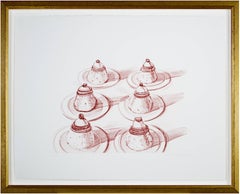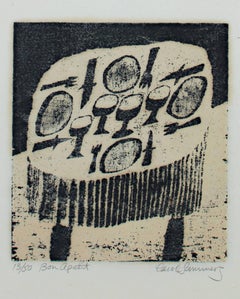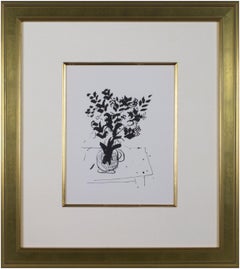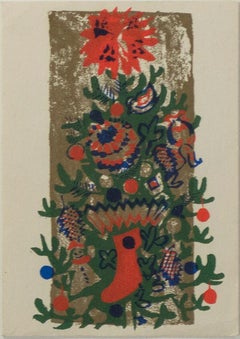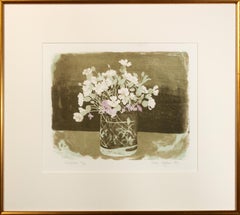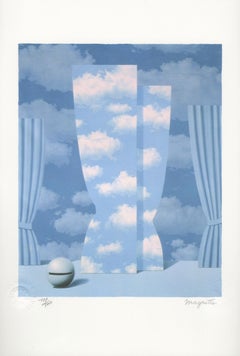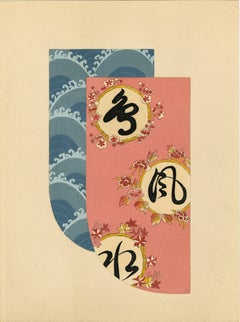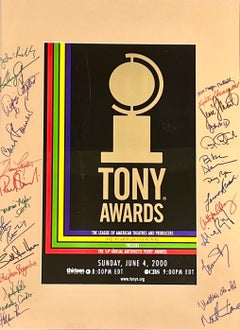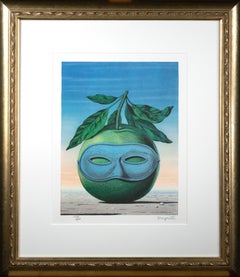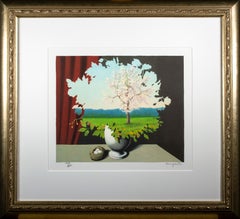Wisconsin - Still-life Prints
to
5
9
8
4
Overall Width
to
Overall Height
to
5
4
3
1
1
1
1
3
2
2
1
1
2
19
5
3
1
1
2
10
14
10
2
10
6
6
4
4
3
3
3
3
2
2
2
2
1
1
1
1
1
1
1
11
4
4
4
3
10
2
2,839
1,164
Item Ships From: Wisconsin
"Italian Desserts, " Etching signed by Wayne Thiebaud
By Wayne Thiebaud
Located in Milwaukee, WI
An etching in red by American pop artist Wayne Thiebaud depicting six Italian desserts. This is #16 from the edition of 50. It is signed and dated in pencil lower right, and numbered...
Category
1970s Contemporary Wisconsin - Still-life Prints
Materials
Etching
"Bon Apetit, " Original Black and White Woodcut by Carol Summers
By Carol Summers
Located in Milwaukee, WI
"Bon Apetit" is an original black and white woodcut by Carol Summers. It depicts a table set for four people. The artist signed the piece in t...
Category
1960s Wisconsin - Still-life Prints
Materials
Woodcut
Black and White Bouquet in Vase on Table, Marc Chagall lithograph
By Marc Chagall
Located in Milwaukee, WI
6 x 6.5 inches, image
14.88 x 11 inches, paper
22.63 x 20.13 inches, frame
Offset lithograph after the original drawing
Framed to conservation standards using 100 percent silk-lined rag matting and museum glass, housed in a gold cassetta-style moulding with a gilded fillet insert
Marc Chagall was born in Liozno, near Vitebsk, now in Belarus, the eldest of nine children in a close-knit Jewish family led by his father Khatskl (Zakhar) Shagal, a herring merchant, and his mother, Feige-Ite. This period of his life, described as happy though impoverished, appears in references throughout Chagall's work. The family home on Pokrovskaya Street is now the Marc Chagall Museum...
Category
1970s Modern Wisconsin - Still-life Prints
Materials
Lithograph
'O'Tannenbaum' original color silkscreen signed on verso, Christmas tree, winter
By Ruth Grotenrath
Located in Milwaukee, WI
'O'Tannenbaum' (Artist's #30129) is an original color silkscreen print by Ruth Grotenrath, signed by the artist on verso. Influenced by the works of Expressionists like Henri Matisse and the woodblock prints of early modern Japanese artists like Katsushika Hokusai, Ruth Grotenrath's 'O'Tannenbaum' combines the expressive use of color of the former with the precision of the latter to create a Christmas card that is as vibrant as it is subtle. Depicting a pine tree decked with ornaments and stockings, Grotenrath has rendered the tree-topping star as a ball of flames to analogize the warmth and spirit of the holiday season.
Original color silkscreen
6.625 x 4 inches, silkscreen
14.375 x 11.375 inches, frame
Signed in screen on verso inside-letter
Framed to conservation standards using archival materials including 100 percent rag matting and mounting materials, Museum Glass to inhibit UV damage and reduce glare, and housed in a gold finish wood frame.
"The paintings of Ruth...
Category
1940s Expressionist Wisconsin - Still-life Prints
Materials
Screen
"Campions, " Lithograph Still Life by Sheila Stafford
By Sheila Stafford
Located in Milwaukee, WI
"Campions" is an original color lithograph by Sheila Stafford. The artist signed the piece in the lower right and titled it and wrote the edition number (24/24) in the lower left - b...
Category
1980s Wisconsin - Still-life Prints
Materials
Lithograph
"La Peine Perdue (The Wasted Effort)" Lithograph after Painting by Rene Magritte
By René Magritte
Located in Milwaukee, WI
"La Peine Perdue (The Wasted Effort)" is a color lithograph after original 1962 painting by Rene Magritte. Two blue curtains are parted on either side. Two curtain shaped mirrors show a sky and clouds. A ball sits right to the left of the mirrors.
Art: 12 x 9.75 in
Frame: 22.75 x 20.38 in
René-François-Ghislain Magritte was born November 21, 1898, in Lessines, Belgium and died on August 15, 1967 in Brussels. He is one of the most important surrealist artists. Through his art, Magritte creates humor and mystery with juxtapositions and shocking irregularities. Some of his hallmark motifs include the bourgeois “little man,” bowler hats, apples, hidden faces, and contradictory texts.
René Magritte’s father was a tailor and his mother was a miller. Tragedy struck Magritte’s life when his mother committed suicide when he was only fourteen. Magritte and his two brothers were thereafter raised by their grandmother.
Magritte studied at the Brussels Academy of Fine Arts from 1916 to 1918. After graduating he worked as a wallpaper designer and in advertisement. It was during this period that he married Georgette Berger, whom he had known since they were teenagers.
In 1926, René Magritte signed...
Category
2010s Surrealist Wisconsin - Still-life Prints
Materials
Lithograph
'Lobsterman's Wharf, Maine' original lithograph signed by "Zsissly" Albright
By Malvin Marr Albright
Located in Milwaukee, WI
'Lobsterman's Wharf, Maine' is an original lithograph signed by Malvin Marr "Zsissly" Albright. While Malvin Marr – along with his better-known identical twin Ivan Albright – was known for his meticulous and unsettling magic realist compositions, he and his brother were also prolific in capturing landscapes of the coast of Maine where the two spent several consecutive summers away from Chicago over their lives. Sometimes these Maine landscapes and views would be painterly and seemingly antithetical to the careful realism of his other work; but in this example, however, the wharf is treated with the same macabre decay as his human subjects. In the composition, the shack...
Category
1940s American Modern Wisconsin - Still-life Prints
Materials
Lithograph
"Bodegon - Still Life: Apple, Pear, & Funnel in Box, " Original Color Lithograph
By Armando Morales
Located in Milwaukee, WI
"Bodegon - Still Life: Apple, Pear & Funnel in Box" is an original color lithograph by Armando Morales. The artist signed the piece and this piece is the presentation proof for the e...
Category
1980s Contemporary Wisconsin - Still-life Prints
Materials
Lithograph
"Counterpoise, " Original Color Lithograph signed by Jeanette Pasin-Sloan
By Jeanette Pasin-Sloan
Located in Milwaukee, WI
"Counterpoise" is an original color lithograph by Jeanette Pasin-Sloan. It features a number of brightly colored hyper-realistic shining glassware. The artist signed the piece lower ...
Category
Early 2000s Photorealist Wisconsin - Still-life Prints
Materials
Lithograph
'Pair of Christmas Golf Balls' gicleé print on watercolor paper
Located in Milwaukee, WI
In this playful gicleé print, the viewer is presented with two golf balls adorned with Christmas-related imagery. The golf ball on the right features Santa ...
Category
2010s Contemporary Wisconsin - Still-life Prints
Materials
Giclée
"Anthunium, " Original Color Serigraph Colorful Still Life signed by Hunt Slonem
By Hunt Slonem
Located in Milwaukee, WI
"Anthunium" is an original color serigraph by Hunt Slonem. The artist signed and dated the piece in the lower right and wrote the edition number, AP 3/30, in the lower left. This piece depicts a still life with patterned pillows and plants.
19 3/4"x 24 1/8"image
22"x 30"paper
29 1/8" x 33 1/2" frame
Hunt Slonem (born Hunt Slonim, July 18, 1951) is an American painter, sculptor, and printmaker. He is best known for his Neo-Expressionist paintings of tropical birds, often based on a personal aviary in which he has been keeping from 30 to over 100 live birds of various species. Slonem's works are included in many important museum collections all over the world; he is exhibiting regularly at both public and private venues, and he has received numerous honors and awards.
Hunt Slonem’s oil paintings...
Category
1980s Wisconsin - Still-life Prints
Materials
Screen
'Untitled' Poster Series Curated by Christophe Boutin and Mélanie Scarciglia
Located in Milwaukee, WI
26 1/4" x 18" art
28.25" x 20" frame
Poster for Untitled, 2017 Poster Series Curated by Christophe Boutin and Mélanie Scarciglia for Untitled, Miami Beach, 2017.
Category
2010s Wisconsin - Still-life Prints
Materials
Digital
'Flowers' original abstract linocut by Wisconsin artist Schomer Lichtner
By Schomer Lichtner
Located in Milwaukee, WI
'Flowers' is an original linocut by Wisconsin-based artist Schomer Lichtner. The composition presents a scattered floral still life amongst abstracted shadows and forms, rendered with Lichtner's quintessential abstract sensibilities. This print is one from a series that each depict abstracted subjects in black silhouette, taking pleasure in the materiality of the linocut technique. The free forms of the flower resemble the lyrical mid-century works of the French artist Henri Matisse, which combined with these material concerns demonstrate Lichter's modern sensibilities. The prints from this series are unusual because of how below the image, Lichtner also includes his Chinese seal and a linocut remarque of a cow, each of which act as an additional signature of the artist on the artwork.
Linocut in black and red on Permalife white wove paper
4 x 5.25 inches, image
11.5 x 8.75 inches, sheet
16.5 x 13.63 inches, frame
Signed in pencil, below image, lower right.
Edition 1/100 in pencil, below image, lower left.
Chinese signature stamp in red, below image, lower right.
Remaque of a cow in red, below image, lower right.
Permalife watermark to paper.
Framed to conservation standards in a shadow-box style mounting, using 100 percent rag matting, museum glass, and housed in a silver-finish wood moulding.
Overall excellent condition with no creases or discoloration.
Milwaukee artist Schomer Lichtner was well known for his whimsical cows and ballerinas and abstract imagery. He and his late wife Ruth Grotenrath, both well-known Wisconsin artists, began their prolific careers as muralists for WPA projects, primarily post offices.
Lichtner also painted murals for industry and private clients. Schomer was a printmaker and produced block prints, lithographs, and serigraph prints. His casein (paint made from dairy products) and acrylic paintings are of the rural Wisconsin landscape and farm animals. He became interested in cows when he and Ruth spent summers near Holy Hill in Washington County. According to David Gordon, director of the Milwaukee Art Museum, Schomer Lichtner had a tremendous joie de vivre and expressed it in his art.
Schomer Lichtner was nationally known for his whimsical paintings and sculptures of black- and white-patterned Holstein cows...
Category
Late 20th Century American Modern Wisconsin - Still-life Prints
Materials
Paper, Black and White, Linocut
"Victoria" original lithograph signed by Malvin Marr "Zsissly" Albright
By Malvin Marr Albright
Located in Milwaukee, WI
The present print, "Victoria," is the most iconic example of the printmaking of Malvin Marr Albright, called Zsissly. The composition for the image comes from Albright's painting from about 1935, done while he was studying at the Art Institute of Chicago. We can see clearly in the image how he possesses the same skill for unsettling, magic realist images as his more famous twin brother Ivan Le Lorraine: The lady Victoria sits at a dining room table, surrounded by luxurious still-life objects. All the textures and surfaces of the image express a horror vacui as seen in his painted works, such as "The Trail of Time is Dust" at the Pennsylvania Academy of Fine Art. The door in this print recalls one of the more famous works by his brother, "That Which I Should Have Done I Did Not Do (The Door)" at the Art Institute of Chicago.
1947, after ca. 1935 original painting
8 1/2 x 13 inches, image
12 x 16 inches, sheet
16 1/4 x 20 1/2 frame
Signed in pencil, lower right
Title in pencil, lower left
Published by Associated American Artists Inc.
Unnumbered from the edition of 250
A painter and sculptor, Malvin Albright was born in Chicago, one of twin sons of Adam Emory Albright, famous Chicago figure painter of juvenile subjects, who often used Malvin and his brother Ivan Le Lorraine as models.
Malvin's middle name, Marr, was after Wisconsin artist Carl von Marr...
Category
1940s American Modern Wisconsin - Still-life Prints
Materials
Lithograph
"Two Bottles & Bowl, " Original Black & White Litho. signed by Joan Gardy Artigas
By Joan Gardy Artigas
Located in Milwaukee, WI
"Two Bottles & Bowl" is an original lithograph by Joan Gardy Artigas. It depicts a still life in black and white. The artist signed the piece lower right and wrote the edition number...
Category
Mid-20th Century Abstract Expressionist Wisconsin - Still-life Prints
Materials
Lithograph
"Boldest Native" original lithograph signed pop art abstract hyperrealistic bold
By Michael Knigin
Located in Milwaukee, WI
"Boldest Native" is an original color lithograph by Michael Knigin. This piece features a pile of apples with abstract textures. The artist signed the piece lower right and titled it...
Category
1980s Pop Art Wisconsin - Still-life Prints
Materials
Lithograph
19th century color lithograph still life vase flowers
By Nathaniel Currier
Located in Milwaukee, WI
The present hand-colored lithograph is one of several decorative images of flower-filled vases published by Nathaniel Currier. This example contains roses, tulips, forget-me-nots, and others all within a vase with gold eagle head handles and an image of a beautiful young woman the belly.
16 x 11 inches, artwork
22.5 x 18.25 inches, frame
Entitled bottom center
Signed in the stone, lower left "Lith. and Pub. by N. Currier"
Inscribed lower right "152 Nassau St. Cor. of Spruce N.Y."
Copyrighted bottom center "Entered according to Act of Congress in the year 1848 by N. Currier in the Clerk's office of the Southern District of N.Y." with the number 249
Framed to conservation standards using 100 percent rag matting, housed in a lemon gold moulding.
Nathaniel Currier was a tall introspective man with a melancholy nature. He could captivate people with his piercing stare or charm them with his sparkling blue eyes. Nathaniel was born in Roxbury, Massachusetts on March 27th, 1813, the second of four children. His parents, Nathaniel and Hannah Currier, were distant cousins who lived a humble yet spartan life. When Nathaniel was eight years old, tragedy struck. Nathaniel’s father unexpectedly passed away leaving Nathaniel and his eleven-year-old brother Lorenzo to provide for the family. In addition to their mother, Nathaniel and Lorenzo had to care for six-year-old sister Elizabeth and two-year-old brother Charles. Nathaniel worked a series of odd jobs to support the family, and at fifteen, he started what would become a life-long career when he apprenticed in the Boston lithography shop of William and John Pendleton.
A Bavarian gentleman named Alois Senefelder invented lithography just 30 years prior to young Nat Currier’s apprenticeship. While under the employ of the brothers Pendleton, Nat was taught the art of lithography by the firm’s chief printer, a French national named Dubois, who brought the lithography trade to America.
Lithography involves grinding a piece of limestone flat and smooth then drawing in mirror image on the stone with a special grease pencil. After the image is completed, the stone is etched with a solution of aqua fortis leaving the greased areas in slight relief. Water is then used to wet the stone and greased-ink is rolled onto the raised areas. Since grease and water do not mix, the greased-ink is repelled by the moisture on the stone and clings to the original grease pencil lines. The stone is then placed in a press and used as a printing block to impart black on white images to paper.
In 1833, now twenty-years old and an accomplished lithographer, Nat Currier left Boston and moved to Philadelphia to do contract work for M.E.D. Brown, a noted engraver and printer. With the promise of good money, Currier hired on to help Brown prepare lithographic stones of scientific images for the American Journal of Sciences and Arts. When Nat completed the contract work in 1834, he traveled to New York City to work once again for his mentor John Pendleton, who was now operating his own shop located at 137 Broadway. Soon after the reunion, Pendleton expressed an interest in returning to Boston and offered to sell his print shop to Currier. Young Nat did not have the financial resources to buy the shop, but being the resourceful type he found another local printer by the name of Stodart. Together they bought Pendleton’s business.
The firm ‘Currier & Stodart’ specialized in "job" printing. They produced many different types of printed items, most notably music manuscripts for local publishers. By 1835, Stodart was frustrated that the business was not making enough money and he ended the partnership, taking his investment with him. With little more than some lithographic stones, and a talent for his trade, twenty-two year old Nat Currier set up shop in a temporary office at 1 Wall Street in New York City. He named his new enterprise ‘N. Currier, Lithographer’
Nathaniel continued as a job printer and duplicated everything from music sheets to architectural plans. He experimented with portraits, disaster scenes and memorial prints, and any thing that he could sell to the public from tables in front of his shop. During 1835 he produced a disaster print Ruins of the Planter's Hotel, New Orleans, which fell at two O’clock on the Morning of the 15th of May 1835, burying 50 persons, 40 of whom Escaped with their Lives. The public had a thirst for newsworthy events, and newspapers of the day did not include pictures. By producing this print, Nat gave the public a new way to “see” the news. The print sold reasonably well, an important fact that was not lost on Currier.
Nat met and married Eliza Farnsworth in 1840. He also produced a print that same year titled Awful Conflagration of the Steamboat Lexington in Long Island Sound on Monday Evening, January 18, 1840, by which melancholy occurrence over One Hundred Persons Perished. This print sold out very quickly, and Currier was approached by an enterprising publication who contracted him to print a single sheet addition of their paper, the New York Sun. This single page paper is presumed to be the first illustrated newspaper ever published.
The success of the Lexington print launched his career nationally and put him in a position to finally lift his family up. In 1841, Nat and Eliza had their first child, a son they named Edward West Currier. That same year Nat hired his twenty-one year old brother Charles and taught him the lithography trade, he also hired his artistically inclined brother Lorenzo to travel out west and make sketches of the new frontier as material for future prints. Charles worked for the firm on and off over the years, and invented a new type of lithographic crayon which he patented and named the Crayola. Lorenzo continued selling sketches to Nat for the next few years.
In 1843, Nat and Eliza had a daughter, Eliza West Currier, but tragedy struck in early 1847 when their young daughter died from a prolonged illness. Nat and Eliza were grief stricken, and Eliza, driven by despair, gave up on life and passed away just four months after her daughter’s death.
The subject of Nat Currier’s artwork changed following the death of his wife and daughter, and he produced many memorial prints and sentimental prints during the late 1840s. The memorial prints generally depicted grief stricken families posed by gravestones (the stones were left blank so the purchasers could fill in the names of the dearly departed). The sentimental prints usually depicted idealized portraits of women and children, titled with popular Christian names of the day.
Late in 1847, Nat Currier married Lura Ormsbee, a friend of the family. Lura was a self-sufficient woman, and she immediately set out to help Nat raise six-year-old Edward and get their house in order. In 1849, Lura delivered a son, Walter Black Currier, but fate dealt them a blow when young Walter died one year later. While Nat and Lura were grieving the loss of their new son, word came from San Francisco that Nat’s brother Lorenzo had also passed away from a brief illness. Nat sank deeper into his natural quiet melancholy. Friends stopped by to console the couple, and Lura began to set an extra place at their table for these unexpected guests. She continued this tradition throughout their lives.
In 1852, Charles introduced a friend, James Merritt Ives, to Nat and suggested he hire him as a bookkeeper. Jim Ives was a native New Yorker born in 1824 and raised on the grounds of Bellevue Hospital where his father was employed as superintendent. Jim was a self-trained artist and professional bookkeeper. He was also a plump and jovial man, presenting the exact opposite image of his new boss.
Jim Ives met Charles Currier through Caroline Clark, the object of Jim’s affection. Caroline’s sister Elizabeth was married to Charles, and Caroline was a close friend of the Currier family. Jim eventually proposed marriage to Caroline and solicited an introduction to Nat Currier, through Charles, in hopes of securing a more stable income to support his future wife.
Ives quickly set out to improve and modernize his new employer’s bookkeeping methods. He reorganized the firm’s sizable inventory, and used his artistic skills to streamline the firm’s production methods. By 1857, Nathaniel had become so dependent on Jims’ skills and initiative that he offered him a full partnership in the firm and appointed him general manager. The two men chose the name ‘Currier & Ives’ for the new partnership, and became close friends.
Currier & Ives produced their prints in a building at 33 Spruce Street where they occupied the third, fourth and fifth floors. The third floor was devoted to the hand operated printing presses that were built by Nat's cousin, Cyrus Currier, at his shop Cyrus Currier & Sons in Newark, NJ. The fourth floor found the artists, lithographers and the stone grinders at work. The fifth floor housed the coloring department, and was one of the earliest production lines in the country. The colorists were generally immigrant girls, mostly German, who came to America with some formal artistic training. Each colorist was responsible for adding a single color to a print. As a colorist finished applying their color, the print was passed down the line to the next colorist to add their color. The colorists worked from a master print displayed above their table, which showed where the proper colors were to be placed. At the end of the table was a touch up artist who checked the prints for quality, touching-in areas that may have been missed as it passed down the line. During the Civil War, demand for prints became so great that coloring stencils were developed to speed up production.
Although most Currier & Ives prints were colored in house, some were sent out to contract artists. The rate Currier & Ives paid these artists for coloring work was one dollar per one hundred small folios (a penny a print) and one dollar per one dozen large folios. Currier & Ives also offered uncolored prints to dealers, with instructions (included on the price list) on how to 'prepare the prints for coloring.' In addition, schools could order uncolored prints from the firm’s catalogue to use in their painting classes.
Nathaniel Currier and James Merritt Ives attracted a wide circle of friends during their years in business. Some of their more famous acquaintances included Horace Greeley, Phineas T. Barnum, and the outspoken abolitionists Rev. Henry Ward, and John Greenleaf Whittier (the latter being a cousin of Mr. Currier).
Nat Currier and Jim Ives described their business as "Publishers of Cheap and Popular Pictures" and produced many categories of prints. These included Disaster Scenes, Sentimental Images, Sports, Humor, Hunting Scenes, Politics, Religion, City and Rural Scenes, Trains, Ships, Fire Fighters, Famous Race Horses, Historical Portraits, and just about any other topic that satisfied the general public's taste. In all, the firm produced in excess of 7500 different titles, totaling over one million prints produced from 1835 to 1907.
Nat Currier retired in 1880, and signed over his share of the firm to his son Edward. Nat died eight years later at his summer home 'Lion’s Gate' in Amesbury, Massachusetts. Jim Ives remained active in the firm until his death in 1895, when his share of the firm passed to his eldest son, Chauncey.
In 1902, faced will failing health from the ravages of Tuberculosis, Edward Currier sold his share of the firm to Chauncey Ives...
Category
1840s Romantic Wisconsin - Still-life Prints
Materials
Watercolor, Lithograph
"Shell Ginger, " Color Serigraph Still Life signed by Hunt Slonem
By Hunt Slonem
Located in Milwaukee, WI
"Shell Ginger" is an original color serigraph by Hunt Slonem. The artist signed the piece in the lower right, titled it lower center, and wrote the edition number (A.P. 16/30) in the lower left. It depicts a chair with an animal skin and plants.
25"x 20 3/8" image
30"x 22" paper
33 1/2 x 28 3/4" frame
Hunt Slonem (born Hunt Slonim, July 18, 1951) is an American painter, sculptor, and printmaker. He is best known for his Neo-Expressionist paintings of tropical birds, often based on a personal aviary in which he has been keeping from 30 to over 100 live birds of various species. Slonem's works are included in many important museum collections all over the world; he is exhibiting regularly at both public and private venues, and he has received numerous honors and awards.
Hunt Slonem’s oil paintings...
Category
1980s Wisconsin - Still-life Prints
Materials
Screen
"The Roses are Coming, " Intaglio Artist Proof VIII by Fred Reichman
By Fred Reichman
Located in Milwaukee, WI
"The Roses are Coming" is an intaglio print AP. VIII from an edition of 100. It is signed lower right by the artist Fred Reichman. It depicts sticks and ...
Category
1980s Wisconsin - Still-life Prints
Materials
Intaglio
Dried Flowers in a Stoneware Vase giclee print spring color gift decor mom
By Kevin Knopp
Located in Milwaukee, WI
This giclee print on canvas is hand embellished with acrylic gel brushstrokes after the 2001 original oil painting. Depicting brightly colored flowers in a vase, this beautiful artwo...
Category
2010s Contemporary Wisconsin - Still-life Prints
Materials
Canvas, Acrylic, Giclée
"St. Sebastian in NY, " Original Aquatint signed by Dan Mitchell Allison
By Dan Mitchell Allison
Located in Milwaukee, WI
"St. Sebastian in N.Y." is an original color aquating by dan Mitchell Allison. The artist signed the piece in the lower right. This piece depicts a heart/apple behind a window being assaulted by small arrows. Cactus-patterned curtains fly away from the windows and five words float in front of the entire image. This piece resembles Rene Magritte's early experiments with text-based surrealism. This piece is edition 38/40.
15 3/8" x 19 5/8" art
22 1/8" x 26 1/4" frame
Born in Houston, Texas in 1953, the printmaker and painter continues to live and work there, still remaining an integral part of the lively Houston art scene while garnering attention throughout the United States, as well as overseas. Allison's prints are included in major museum and private collections throughout the world, including the U.S., Europe and Asia. He has gained renown for his innovative painting with the surface subtleties of printmaking and has established an international reputation for printmaking that places him in league with some of the most important late 20th century artists to have worked in the print medium.
Achieving worldwide critical acclaim for his printmaking, Allison was the recipient of the prestigious 1987 Grand Prix award for the 17th Biennial of Graphic Art sponsored by the Ljubljana Museum of Modern Art in the former Republic of Yugoslavia. The artist's award winning, three panel collagraphic triptych, "Between Heaven and Earth," was selected from more than 1800 entries submitted from 57 countries. Past recipients of Ljubljana print award honors include Joan Miro, Karl Appel, Jasper Johns, Robert Rauschenberg, Frank Stella, James Rosenquist, David Hockney, Victor Vasarely, Antonio Berni...
Category
1980s Surrealist Wisconsin - Still-life Prints
Materials
Aquatint
"Lobster, " Original Color Still Life Serigraph signed by Hunt Slonem
By Hunt Slonem
Located in Milwaukee, WI
"Lobster" is an original color serigraph by Hunt Slonem. The artist signed and dated the piece lower right, wrote the title lower center, and the edition number (AP/2) in the lower left. This piece depicts a still life of patterned pillows, vegetables, and animals.
19"x 19"image
21 7/8"x 29 3/4"paper
31 1/2 x 31 1/2" frame
Hunt Slonem (born Hunt Slonim, July 18, 1951) is an American painter, sculptor, and printmaker. He is best known for his Neo-Expressionist paintings of tropical birds, often based on a personal aviary in which he has been keeping from 30 to over 100 live birds of various species. Slonem's works are included in many important museum collections all over the world; he is exhibiting regularly at both public and private venues, and he has received numerous honors and awards.
Hunt Slonem’s oil paintings...
Category
1980s Neo-Expressionist Wisconsin - Still-life Prints
Materials
Screen
Original Victorian card with flower arrangement and ice skating scene
Located in Milwaukee, WI
Business cards like this fall into the category of what art historians today generally refer to as "ephemera." Ones like this were produced for companies in the late 19th century, pr...
Category
1890s Romantic Wisconsin - Still-life Prints
Materials
Lithograph
"Still Life with Teapot, New Year's Edition, " Original Aquatint by A. Antonni
Located in Milwaukee, WI
"Still Life with Teapot, New Year's Edition" is an original aquatint by A. Antonni. This piece depicts a still life in gray. Antonni creates original aquatint prints, sometimes of a ...
Category
1980s Other Art Style Wisconsin - Still-life Prints
Materials
Aquatint
"Leaves & Berries" giclée print after ca. 1950s original watercolor and collage
By Sylvia Spicuzza
Located in Milwaukee, WI
14.75 x 17.75 inches, artwork
22.88 x 25.75 inches, frame
Born in 1908, Sylvia Spicuzza was the daughter of noted painter Francesco Spicuzza. Sylvia devoted herself to teaching art ...
Category
1950s Modern Wisconsin - Still-life Prints
Materials
Giclée, Watercolor
"Wounded Fruit, " Color Aquatint sigend by Dan Mitchell Allison
By Dan Mitchell Allison
Located in Milwaukee, WI
"Wounded Fruit" is an original color aquatint by Dan Mitchell Allison. It depicts a banana behind a window with an arrow through it. There are also color names written on the piece. It recalls Rene Magritte's early surreal explorations of objects and text. The artist signed the piece in the lower right. It is edition 39/40.
15 1/2" x 19 1/2" art
22 1/4" x 26" frame
Born in Houston, Texas in 1953, the printmaker and painter continues to live and work there, still remaining an integral part of the lively Houston art scene while garnering attention throughout the United States, as well as overseas. Allison's prints are included in major museum and private collections throughout the world, including the U.S., Europe and Asia. He has gained renown for his innovative painting with the surface subtleties of printmaking and has established an international reputation for printmaking that places him in league with some of the most important late 20th century artists to have worked in the print medium.
Achieving worldwide critical acclaim for his printmaking, Allison was the recipient of the prestigious 1987 Grand Prix award for the 17th Biennial of Graphic Art sponsored by the Ljubljana Museum of Modern Art in the former Republic of Yugoslavia. The artist's award winning, three panel collagraphic triptych, "Between Heaven and Earth," was selected from more than 1800 entries submitted from 57 countries. Past recipients of Ljubljana print award honors include Joan Miro, Karl Appel, Jasper Johns, Robert Rauschenberg, Frank Stella, James Rosenquist, David Hockney, Victor Vasarely, Antonio Berni...
Category
1980s Surrealist Wisconsin - Still-life Prints
Materials
Aquatint
Related Items
Kimono Fabric Design
Located in Fairlawn, OH
Color woodcut with pochoir embellishments on fine silver mica ground
By Kano Shuho, or Yamakawa Shuho, 20th century Japanese Artist
Category
1930s Wisconsin - Still-life Prints
Materials
Woodcut
2000 Tony Awards Poster Signed by Celebrity Presenters Autographed Broadway
Located in New York, NY
2000 Tony Awards Poster Signed by Celebrity Presenters Autographed Broadway
Offered is the 2000 Tony Awards poster signed by the presenters, including: Matthew Broderick, Kristen Chenoweth, Kelsey Grammer, Jane Krakowski, Bernadette Peters, Ann Reinking...
Category
Early 2000s Performance Wisconsin - Still-life Prints
Materials
Paper, Color
Original Italian Emidio di Nola Italian Macaroni original vintage food poster
Located in Spokane, WA
Emidio di Nola, original Italian pasta poster. Size 19" x 25.5". Professional acid-free archival linen-backed; in excellent condition; ready to frame....
Category
1950s Aesthetic Movement Wisconsin - Still-life Prints
Materials
Lithograph
$750
H 25.5 in W 19 in D 0.05 in
Bouquet de Tulipes Rouge, Original Lithograph, Signed and Numbered
By Roger Mühl
Located in New York, NY
This magnificent bouquet of Red Tulips is an original lithograph by famous French artist Roger Muhl. The elegant lines and joyful colors are typical of the artist's love for nature and its flora. Roger Muhl lived in the town of Mougins in the South of France and he was strongly inspired by the bright and warm light found in the Mediterranean.
This original lithograph is from a signed and numbered edition in pencil by artist of 175 plus 10 artist proofs. Printed and published by Edition E.F. Mourlot in 1990
Certificate of Provenance:
Each individual work of art carefully curated by Mourlot Editions...
Category
1990s Modern Wisconsin - Still-life Prints
Materials
Lithograph
$2,000
H 26.75 in W 28 in
Magnolia 10 - Contemporary Figurative Drypoint Etching Print, Flower, Floral
By Marta Wakula-Mac
Located in Warsaw, PL
MARTA WAKUŁA-MAC: Master of Arts in Fine Art Education- Diploma in Fine Art Printmaking at the Institute of Art, Pedagogical University, Krakow, 2003. Member of Graphic Studio Dubl...
Category
2010s Contemporary Wisconsin - Still-life Prints
Materials
Paper, Drypoint, Etching
Untitled (Still Life)
Located in Fairlawn, OH
Untitled (Still Life)
Etching, aquatint and soft ground, 2001
Signed in pencil (see photo)
Edition: 260
Published by the Print Club of Cleveland, Publication 80, 2002
Printed by Felix Harlan at Harlan and Weaver, New York
William Bailey, Modernist Figurative Painter, Dies at 89
He swathed his nudes and still lifes of eggs, vases, bottles and bowls in a breathless, deceptively serene atmosphere heavy with mystery.
The painter William Bailey in 2009. He was never given a career survey in a major museum, but his influence, particulary on students at Yale, was deep.Credit...Ford Bailey
By William Grimes for the New York Times
April 18, 2020
William Bailey, whose pristine, idealized still lifes and female nudes made him one of the leading figures in the return of figurative art in the 1980s, died on April 13 at his home in Branford, Conn. He was 89.
His death was confirmed by his daughter, Alix Bailey.
Beyond his painting, Mr. Bailey influenced generations of students in his many years as a teacher at the Yale School of Art.
In some of his best-known work, Mr. Bailey arranged simple objects — the eggs, bowls, bottles and vases that he once called “my repertory company” — along a severe horizontal shelf, or on a plain table, swathing them in a breathless, deceptively serene atmosphere heavy with mystery.
His muted ochres, grays and powdery blues conjured up a still, timeless world inhabited by Platonic forms, recognizable but uncanny, in part because he painted from imagination rather than
“They are at once vividly real and objects in dream, and it is the poetry of this double life that elevates all this humble crockery to the realm of pictorial romance,” Hilton Kramer wrote in The New York Times in 1979.
Mr. Bailey’s female figures, some clothed in a simple shift or robe and others partly or entirely nude, are disconcertingly impassive, implacable and unreadable, fleshly presences breathing an otherworldly air.
The critic Mark Stevens, writing in Newsweek in 1982, credited Mr. Bailey with helping to “restore representational art to a position of consequence in modern painting.”
But his version of representation was entirely idiosyncratic, seemingly traditional but in fact “a modernism so contrarian,” the artist Alexi Worth wrote in a catalog essay for the Betty Cuningham Gallery in 2010, “that it feels, despite its historical sophistication, almost like a brand of outsider art.”
William Harrison Bailey...
Category
Early 2000s Contemporary Wisconsin - Still-life Prints
Materials
Etching
Chrysanthemums
Located in Fairlawn, OH
Chrysanthemums
Color woodcut, c. 1950's
Signed lower right (see photo)
Publisher: Uchida (see photo of red seal)
Note: Chrysanthemums, a symbol of the sun, the Japanese consider the ...
Category
1950s Modern Wisconsin - Still-life Prints
Materials
Woodcut
UNICEF Bouquet - Tom Wesselmann, Pop Art, Still-life, Print, Screenprint
By Tom Wesselmann
Located in London, GB
Screenprint in colours, 1998.
From 'Meine Kindheit - Schmerz und Heilung, UNICEF'.
Signed in pencil, numbered from the edition of 100.
Image: 63.5 x 54.5 cm Sheet: 78.8 x 70 cm
Category
1990s Pop Art Wisconsin - Still-life Prints
Materials
Screen
$12,333
H 31.03 in W 27.56 in
DAYTIME KEY Signed Lithograph, Mini Beachscape, Red Box, Sand, Sea, Blue Sky
By Fanny Brennan
Located in Union City, NJ
DAYTIME KEY is a rarely seen, hand drawn limited edition lithograph by the American surrealist artist Fanny Brennan, created using traditional hand lithography techniques printed on archival Arches paper, 100% acid-free. DAYTIME KEY is an engaging miniature beachscape scene depicting a sandy shoreline, blue sky, and vibrant red locking...
Category
1990s Surrealist Wisconsin - Still-life Prints
Materials
Lithograph
Magnolia 11 - Contemporary Figurative Drypoint Etching Print, Flower, Floral
By Marta Wakula-Mac
Located in Warsaw, PL
MARTA WAKUŁA-MAC: Master of Arts in Fine Art Education- Diploma in Fine Art Printmaking at the Institute of Art, Pedagogical University, Krakow, 2003. Member of Graphic Studio Dubl...
Category
2010s Contemporary Wisconsin - Still-life Prints
Materials
Drypoint, Paper, Etching
Anemone per Antipasti, Lithograph by Salvador Dali 1972
By Salvador Dalí
Located in Long Island City, NY
Artist: Salvador Dali, Spanish (1904 - 1989)
Title: Anemone per Antipasti (Anemone of the Toreador)
Year: 1972
Medium: Lithograph with embossing on heavy Arches paper, signed and num...
Category
1970s Surrealist Wisconsin - Still-life Prints
Materials
Lithograph
$3,500
H 29.5 in W 21.75 in D 0.1 in
Curtains, Pop Art Screenprint by Hunt Slonem
By Hunt Slonem
Located in Long Island City, NY
Artist: Hunt Slonem, American (1951 - )
Title: Curtains
Year: 1981
Medium: Serigraph, signed and numbered in pencil
Edition: HC 10
Image Size: 22 x 26.5 inches
Size: 26 ...
Category
1980s Contemporary Wisconsin - Still-life Prints
Materials
Screen
Previously Available Items
"Souvenir de Voyage (Memory of a Journey), " Lithograph after Rene Magritte
By René Magritte
Located in Milwaukee, WI
"Souvenir de voyage (Memory of a Journey)" is a color lithograph after the original 1961 painting by Rene Magritte. A perplexing composition containing a giant green apple standing on a beach surrounded by rocks and the sea, all backlit by a two-toned sunset. A blue masquerade mask adorns the apple with narrow eyes. The anthropomorphized fruit appears to be watching very closely over the viewer.
Artworks entirely made in France: from the production of the paper in Arches in the Vosges department to the traditional lithographic printing process, one drawing for each different color, one color per press run.
The lithographs were authorized, supervised, and validated by the ADAGP (Society of Authors in the Graphic and Plastic Arts) and by Mr. Charly Herscovici, President of the Magritte Foundation, Chairman of the Magritte Museum, and unique representative of the Magritte Succession.
Each lithograph features the dry stamps of the Magritte Foundation & ADAGP and is countersigned in pencil by Mr. Charly Herscovici. A proof of edition is printed on the back of each lithograph, guaranteeing its authenticity.
Art: 13 x 9.87
Frame: 23.63 x 20.38 in
Framed to conservation standards. Surrounded by a wide 100% cotton matboard border with a rounded moulding and filigree details, in an antique brushed gold finish
René-François-Ghislain Magritte was born November 21, 1898, in Lessines, Belgium and died on August 15, 1967 in Brussels. He is one of the most important surrealist artists. Through his art, Magritte creates humor and mystery with juxtapositions and shocking irregularities. Some of his hallmark motifs include the bourgeois “little man,” bowler hats, apples, hidden faces, and contradictory texts.
René Magritte’s father was a tailor and his mother was a miller. Tragedy struck Magritte’s life when his mother committed suicide when he was only fourteen. Magritte and his two brothers were thereafter raised by their grandmother.
Magritte studied at the Brussels Academy of Fine Arts from 1916 to 1918. After graduating he worked as a wallpaper designer and in advertisement. It was during this period that he married Georgette Berger, whom he had known since they were teenagers.
In 1926, René Magritte signed a contract with the Brussels Art Gallery, which allowed him to quit his other jobs and focus completely on creating art. A year later he had his first solo show at the Galerie la Centaurie in Brussels. At this show Magritte exhibited what is today thought of as his first surrealist piece, The Lost Jockey, painted in 1926. In this work a jockey and his steed run across a theater stage, curtains parted on either side. Throughout the scene, there are trees with trunks shaped somewhat like chess pawns with musical scores running vertically up their sides and branches sticking out from all angles. Critics did not enjoy this style of art; it was new, different, and took critical thought to understand, but The Lost Jockey was only the first of many surrealist artworks Magritte would paint.
Because of the bad press in Brussels, René and Georgette moved to Paris in 1927, with the hope that this center of avant-garde art would bring him success and recognition. In Paris, he was able to become friends with many other surrealists, including André Breton and Paul Éluard. They were able to learn from and inspire one another, pushing the Surrealist movement further forward.
It was also in Paris that Magritte decided to add text to some of his pieces, which was one of the elements that made his artwork stand out. In 1929, he painted one of his most famous oil works: The Treachery of Images. This is the eye-catching piece centered on a pipe. Below the pipe is written “Ceci n’est pas un pipe,” which translates to “This is not a pipe.” This simple sentence upset many critics of the time, for of course it was a pipe. Magritte replied that it was not a pipe, but a representation of a pipe. One could not use this oil on canvas as a pipe, to fill it with tobacco and smoke it. Thus, it was not a pipe.
In 1930, Magritte and Georgette moved back to Brussels. Though they would travel to his exhibitions elsewhere, their home going forward would always be in Brussels.
Magritte had his first American exhibition at the Julien Levy Gallery in New York City in 1936 and his first show in England two years later in 1938 at The London Gallery...
Category
2010s Surrealist Wisconsin - Still-life Prints
Materials
Lithograph
"Le Plagiat (Plagiarism), " Lithograph after the 1940 Painting by Rene Magritte
By René Magritte
Located in Milwaukee, WI
"Le Plagiat (Plagiarism)" is a color lithograph after the original 1940 painting by Rene Magritte. A delicate still-life is situated on a table. Three tiny eggs sit in a nest and a vase full of vegetation is next to them. Instead of showing flowers and leaves the blooms show a view of a pleasant field. The field holds a blooming tree.
Art: 9.75 x 11.75 in
Frame: 20.38 x 22.38 in
René-François-Ghislain Magritte was born November 21, 1898, in Lessines, Belgium and died on August 15, 1967 in Brussels. He is one of the most important surrealist artists. Through his art, Magritte creates humor and mystery with juxtapositions and shocking irregularities. Some of his hallmark motifs include the bourgeois “little man,” bowler hats, apples, hidden faces, and contradictory texts.
René Magritte’s father was a tailor and his mother was a miller. Tragedy struck Magritte’s life when his mother committed suicide when he was only fourteen. Magritte and his two brothers were thereafter raised by their grandmother.
Magritte studied at the Brussels Academy of Fine Arts from 1916 to 1918. After graduating he worked as a wallpaper designer and in advertisement. It was during this period that he married Georgette Berger, whom he had known since they were teenagers.
In 1926, René Magritte signed a contract with the Brussels Art Gallery, which allowed him to quit his other jobs and focus completely on creating art. A year later he had his first solo show at the Galerie la Centaurie in Brussels. At this show Magritte exhibited what is today thought of as his first surrealist piece, The Lost Jockey, painted in 1926. In this work a jockey and his steed run across a theater stage, curtains parted on either side. Throughout the scene, there are trees with trunks shaped somewhat like chess pawns with musical scores running vertically up their sides and branches sticking out from all angles. Critics did not enjoy this style of art; it was new, different, and took critical thought to understand, but The Lost Jockey was only the first of many surrealist artworks Magritte would paint.
Because of the bad press in Brussels, René and Georgette moved to Paris in 1927, with the hope that this center of avant-garde art would bring him success and recognition. In Paris, he was able to become friends with many other surrealists, including André Breton and Paul Éluard. They were able to learn from and inspire one another, pushing the Surrealist movement further forward.
It was also in Paris that Magritte decided to add text to some of his pieces, which was one of the elements that made his artwork stand out. In 1929, he painted one of his most famous oil works: The Treachery of Images. This is the eye-catching piece centered on a pipe. Below the pipe is written “Ceci n’est pas un pipe,” which translates to “This is not a pipe.” This simple sentence upset many critics of the time, for of course it was a pipe. Magritte replied that it was not a pipe, but a representation of a pipe. One could not use this oil on canvas as a pipe, to fill it with tobacco and smoke it. Thus, it was not a pipe.
In 1930, Magritte and Georgette moved back to Brussels. Though they would travel to his exhibitions elsewhere, their home going forward would always be in Brussels.
Magritte had his first American exhibition at the Julien Levy Gallery in New York City in 1936 and his first show in England two years later in 1938 at The London Gallery...
Category
2010s Surrealist Wisconsin - Still-life Prints
Materials
Lithograph
The Three Fish Tobago
Located in Milwaukee, WI
Working within a predominantly abstractionist context, a group of younger artists forged a mode of representational art in the 1950s and 1960s that made use of Abstract Expressionist...
Category
2010s Wisconsin - Still-life Prints
Materials
Giclée
"God Made the Lesser Light" Giclée print after original lithograph by Abel Pann
By Abel Pann
Located in Milwaukee, WI
"God Made the Lesser Light" is a Giclée print on watercolor paper after the original lithograph from Abel Pann's portfolio, "The Bible - Genesis: From the Creation until the Deluge."...
Category
1920s French School Wisconsin - Still-life Prints
Materials
Giclée
'Flower' original abstract linocut in black by Wisconsin artist Schomer Lichtner
By Schomer Lichtner
Located in Milwaukee, WI
'Flower' is an original linocut by Wisconsin-based artist Schomer Lichtner. The composition presents a five-petaled flower amonst abstracted shadows and forms, rendered with Lichtner's quintessential abstract sensibilities. This print is one from a series that each depict abstracted subjects in black silhouette, taking pleasure in the materiality of the linocut technique. The free forms of the flower resemble the lyrical mid-century works of the French artist Henri Matisse, which combined with these material concerns demonstrate Lichter's modern sensibilities. The prints from this series are unusual because of how below the image, Lichtner also includes his Chinese seal and a linocut remarque of a cow, each of which act as an additional signature of the artist on the artwork.
Linocut in black and red on Permalife white wove paper
4.25 x 5.25 inches, image
11.5 x 8.75 inches, sheet
16.5 x 13.63 inches, frame
Signed in pencil, below image, lower right.
Edition 1/100 in pencil, below image, lower left.
Chinese signature stamp in red, below image, lower right.
Remaque of a cow in red, below image, lower right.
Permalife watermark to paper.
Framed to conservation standards in a shadow-box style mounting, using 100 percent rag matting, museum glass, and housed in a silver-finish wood moulding.
Overall excellent condition with no creases or discoloration.
Milwaukee artist Schomer Lichtner was well known for his whimsical cows and ballerinas and abstract imagery. He and his late wife Ruth Grotenrath, both well-known Wisconsin artists...
Category
Late 20th Century American Modern Wisconsin - Still-life Prints
Materials
Paper, Black and White, Linocut
'Tribute' original artist's proof serigraph signed by Hunt Slonem
By Hunt Slonem
Located in Milwaukee, WI
The present serigraph is an vibrant example of Hunt Slonem's early printmaking output. In the still life are prized treasures that reflect his childhood: pillows patterned with flora...
Category
1980s Neo-Expressionist Wisconsin - Still-life Prints
Materials
Screen
H 30.25 in W 33.63 in D 1.5 in
Bird on a Swing, from Recent Etchings I by Wayne Thiebaud
By Wayne Thiebaud
Located in Milwaukee, WI
"Bird on a Swing" is a striking and quiet example of the Pop Art images of the artist Wayne Thiebaud, using his bright coloration for a single figure in an empty setting...
Category
1970s Pop Art Wisconsin - Still-life Prints
Materials
Etching, Aquatint
"Framboisier (Raspberry Bush)" original color lithograph and etching by Dalí
By Salvador Dalí
Located in Milwaukee, WI
The present artwork is a a signed original color lithograph and drypoint by Salvador Dali and it is an exemplary work of the kind of printmaking Dali undertook during the late 1960s....
Category
1960s Surrealist Wisconsin - Still-life Prints
Materials
Etching, Lithograph
"Le Pays des Miracles (The Land of Miracles), " Lithograph after Rene Magritte
By (after) René Magritte
Located in Milwaukee, WI
"Le Pays des Miracles (The Land of Miracles)" is a color lithograph after the original 1964 painting by Rene Magritte. This still-life shows a nes...
Category
Early 2000s Surrealist Wisconsin - Still-life Prints
Materials
Lithograph
"La Trahison des Images (The Treachery of Images), " Litho after Rene Magritte
By René Magritte
Located in Milwaukee, WI
"La Trahison des images (The Treachery of Image)" is a color lithograph after 1929 original oil on canvas by Rene Magritte. This classic piece shows a pipe and bellow it is written "...
Category
2010s Surrealist Wisconsin - Still-life Prints
Materials
Lithograph
"Souvenir de voyage (Memory of a Journey)" Litho after Painting by Rene Magritte
By René Magritte
Located in Milwaukee, WI
"Souvenir de voyage (Memory of a Journey)" is a color lithograph after the original 1962-3 painting by Rene Magritte. A concrete, gigantic apple sits on the beach. Behind it is the o...
Category
2010s Surrealist Wisconsin - Still-life Prints
Materials
Lithograph
"Un Peu de l'ame des bandits (Something of the Bandit Spirit)" after Magritte
By René Magritte
Located in Milwaukee, WI
"Un peu de l'ame des bandits (Something of the Bandit Spirit)" is a color lithograph after the original 1960 painting by Rene Magritte. A violin sits on the table. A white collar sit...
Category
2010s Surrealist Wisconsin - Still-life Prints
Materials
Lithograph
